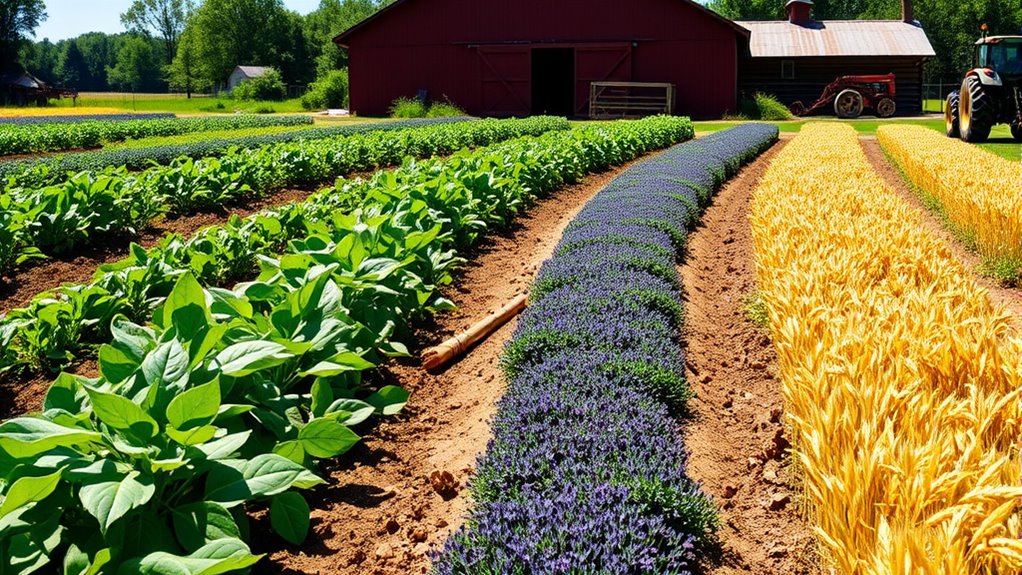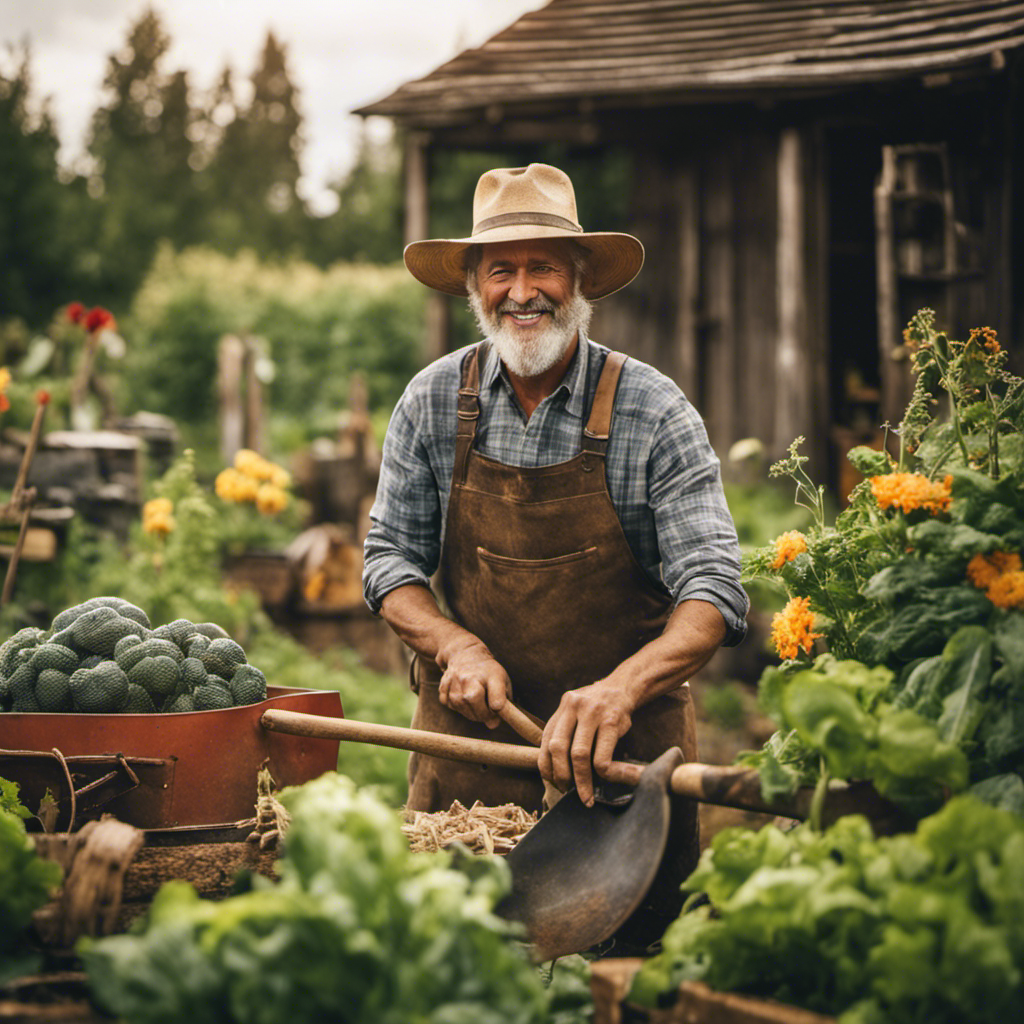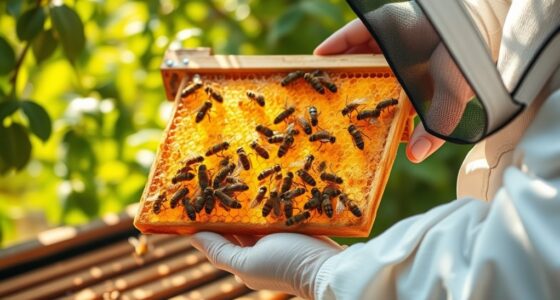To manage a farmstead crop rotation for soil health, plan your crop sequence carefully, including cover crops like clover or rye that improve soil structure, fix nitrogen, and prevent erosion. Rotate crops to reduce disease and pest buildup, and select plants suited to your climate and soil. Keep detailed records to optimize results over time. Continuing with these strategies will help you build a sustainable, productive farm ecosystem.
Key Takeaways
- Plan crop sequences to include legumes, grasses, and root crops that enhance soil fertility and break disease cycles.
- Incorporate cover crops like clover, rye, or vetch to prevent erosion, improve soil structure, and increase organic matter.
- Rotate crops annually to prevent pest buildup, reduce disease risk, and promote a balanced ecosystem.
- Maintain detailed records of crop history, yields, and soil conditions to refine rotation strategies over time.
- Use natural pest management by planting cover crops that attract beneficial insects and release pest-deterring compounds.

Farmstead crop rotation is a proven strategy to improve soil health and boost farm productivity. When you rotate crops thoughtfully, you prevent soil depletion and create a more resilient farming system. One essential practice to include in your rotation plan is the use of cover crops. Cover crops, such as clover, vetch, or rye, are planted during off-season periods or between main crops to protect and enrich the soil. They help reduce erosion, improve soil structure, and increase organic matter, which benefits the entire farm ecosystem. By planting cover crops, you also suppress weeds naturally and minimize the need for chemical herbicides, making your farm more sustainable.
Cover crops like clover and rye enhance soil health and reduce erosion naturally.
In addition to soil benefits, cover crops play a vital role in pest management. They act as natural barriers, interrupting pest life cycles and reducing the habitat for pests and their hosts. For example, certain cover crops can attract beneficial insects like ladybugs or predatory beetles that prey on common pests, helping you keep pest populations under control without relying heavily on pesticides. Some cover crops release compounds that deter pests directly, further aiding your pest management efforts. Integrating cover crops into your crop rotation not only boosts soil health but also creates a balanced ecosystem that naturally limits pest issues.
Managing a successful crop rotation involves planning ahead and understanding the specific needs of your farm. You should select cover crops suited to your climate, soil type, and market crops. For instance, legumes like clover or beans fix nitrogen in the soil, providing natural fertilization for subsequent crops. Grasses like rye or oats can help break disease cycles and improve soil structure. When you rotate crops, avoid planting the same family or species repeatedly in the same spot, which can lead to disease buildup and pest problems. Instead, alternate crops so that pests and diseases don’t become established, reducing the need for chemical interventions.
Keep detailed records of your crop rotations, noting what worked well and what didn’t. This way, you can refine your strategies over time, ensuring each crop rotation cycle enhances soil health, manages pests effectively, and maximizes yields. Remember, crop rotation isn’t just about changing what you plant; it’s about creating a synergistic system where soil, plants, and pests are kept in balance. Incorporating cover crops thoughtfully into this system helps you achieve sustainable, productive farming that benefits both your land and your bottom line. Additionally, understanding the importance of soil health can lead to long-term improvements in farm productivity.
Frequently Asked Questions
How Does Crop Rotation Impact Pest Populations?
Crop rotation greatly impacts pest populations by promoting pest suppression through increased crop diversity. When you rotate different crops, pests that target a specific plant struggle to find their preferred food, reducing their numbers naturally. This diversity interrupts pest life cycles and minimizes infestations, meaning you rely less on chemical controls. By intentionally planning your rotation, you create a healthier, more balanced system that keeps pests in check and supports overall farm productivity.
What Are the Economic Benefits of Crop Rotation?
Crop rotation offers significant economic benefits by promoting crop yield optimization and encouraging economic diversification. You can reduce input costs like fertilizers and pesticides, since healthier soil needs fewer chemicals. Diversifying crops minimizes risks from market fluctuations and pests, boosting overall profitability. By rotating crops effectively, you maximize land productivity, increase income stability, and create a resilient farm system that supports long-term economic growth.
How Can Crop Rotation Improve Water Retention?
Think of your soil as a sponge; crop rotation acts like a gentle squeeze, improving its ability to retain water. By planting cover crops, you boost soil moisture conservation and enhance cover crop benefits. These practices create a protective layer, reducing runoff and evaporation, helping your soil conserve water better. This natural cycle ensures your land stays resilient, healthier, and more productive, even during dry spells.
Are There Specific Crops Best for Nitrogen Fixation?
You should focus on legume selection and cover crop choices to enhance nitrogen fixation. Legumes like clover, peas, and beans are excellent because they naturally convert atmospheric nitrogen into soil-available forms. When selecting cover crops, choose species known for high nitrogen fixation, such as vetch or alfalfa. Incorporating these into your rotation boosts soil fertility, reduces the need for synthetic fertilizers, and supports healthy crop growth.
How Does Crop Rotation Influence Farm Biodiversity?
Crop rotation considerably influences your farm’s biodiversity by enhancing soil diversity and increasing crop variety. When you rotate different plant types, you create a balanced ecosystem that attracts diverse beneficial insects, microbes, and plants. This variety reduces pests and diseases, promotes healthier soil, and supports a resilient farm ecosystem. By diversifying your crops, you foster a thriving environment, ensuring long-term productivity and sustainability for your farm.
Conclusion
So there you have it—master the art of crop rotation, and your soil will thank you with bountiful harvests. Ignore these tips, and you might as well set up a perpetual mud pie stand. Remember, a healthy farmstead isn’t built on guesswork but on smart, strategic planning. So go ahead, boldly rotate those crops, and watch your soil transform from tired to triumphant—because who knew soil health could be so revolutionary?










